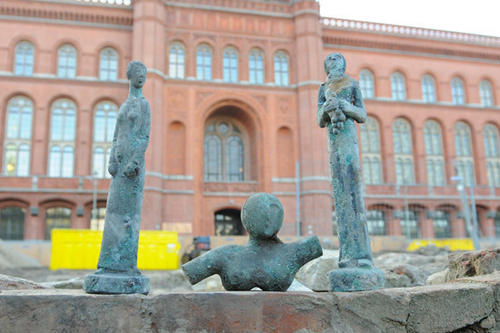Art Historians at Freie Universität Berlin Identify “Degenerate Art”
Members of the research center study the latest sculptures unearthed during the excavation work in front of Berlin’s Rotes Rathaus (Red City Hall)
Nov 26, 2010
Discovered during excavation in front of Berlin City Hall: Sculptures by Gustav Heinrich Wolff (standing robed figure, left); Naum Slutzky (female bust, center); unidentified figure
Image Credit: Landesdenkmalamt Berlin
The trench around the Rotes Rathaus doesn’t look especially promising in artistic terms: It is part of the excavation work for an extension of the number 5 U-Bahn, or subway, line. But the belowground construction site recently turned out to be a real treasure trove of art, when eleven statues were found there after having been labeled “degenerate art” by the Nazi regime. Art historians at Freie Universität helped to trace the works of art, which had been thought lost, to their creators.
“The findings are sensational,” says Meike Hoffmann. “Works of art that the Nazis had intended for destruction, or had been thought missing to this day, suddenly reappear and point us in completely new directions in our research.” Hoffmann, who holds a doctorate in art history, is a researcher and project coordinator at the “Degenerate Art” research center at Freie Universität, founded in 2002.
And so the unique discovery was made: This past fall, the head of the excavation work and state archaeologist of Berlin, Matthias Wemhoff, informed Meike Hoffmann of the find and asked her for help identifying the objects. Wemhoff is the director of the Berlin Museum of Prehistory and Early History and an adjunct professor at Freie Universität at the same time.
All Information Accessible in Online Database of the “Degenerate Art” Research Center
Working together with employees of the Georg Kolbe Museum, Hoffmann and her colleagues from the research center were able to positively identify eight of the eleven sculptures that had been found. “The works are all among those seized in the ‘degenerate art’ campaign in 1937,” Hoffmann says. The researchers from the research center were able to supply historical illustrations and depictions of the pieces alongside information on the objects themselves, the museums where they originated, their seizure and storage, and their provenance. Now all of this information is publicly accessible in the online database operated by the “Degenerate Art” research center – all the user has to do is enter “Berlin, Neues Museum” as search terms.
Public Aid Solicited: Who Can Identify the Pieces That Have Not Yet Been Identified?
The sculptures that were found include the figure “The Dancer” by Margarete Moll, a black glazed head made of terra cotta by artist Otto Freundlich, and a “standing robed figure” by Gustav Heinrich Wolff. All eleven sculptures are currently on exhibit at the Neues Museum in Berlin. The three works that are as yet unidentified can also be viewed on the research center’s website. The researchers have appealed to the public and welcome any information that may help: “Anyone who knows what these art objects are is welcome to contact us,” says Hoffmann. “Every little piece of information will help.”
The sculptures were found on the grounds of a house where Erhard Oewerdieck, a tax advisor and escrow agent, and others lived during the Third Reich. “It is still completely unclear what connection the people who lived in the house had with the works of art, and how they wound up there,” Hoffmann says.
Further Information
Dr. Meike Hoffmann
Art History Institute – “Degenerate Art” Research Center
Tel.: +49-(0)30-838-54523

